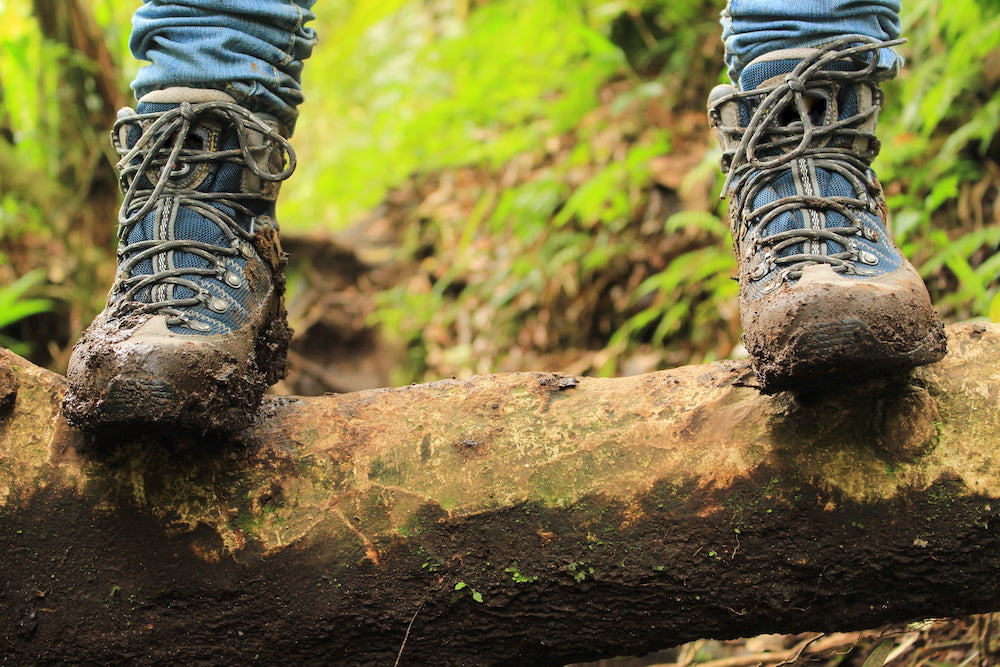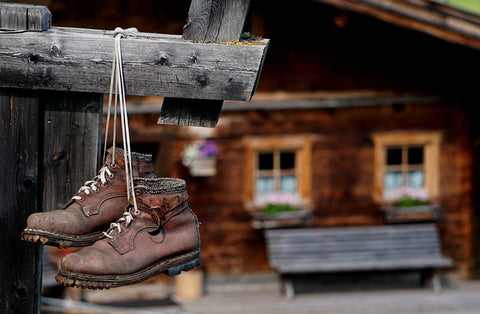Your Cart is Empty

Your trusty hiking boots carry you over miles of uneven terrain, keeping your feet safe, dry, and comfortable. While they are carefully designed to hold up a strong defense against rough trail conditions and foot injuries, they aren’t indestructible. And dirt is one of their biggest adversaries.
Cleaning your hiking boots properly will maintain their performance for years to come and halt the premature aging process of the leather. It will also ensure they are trail-ready whenever you have the itch to unplug, head outside, and appreciate the wonders of nature.
If you are not sure exactly how to wash hiking boots, read on. Here’s what we will cover:
You might be wondering what is the point of cleaning outdoor footwear. After all, they are crafted to take on muddy and gritty trails and will inevitably get mucky again. So, why bother? Here are 5 few good reasons why you need to care for your outdoor footwear.
As a rule of thumb, you should clean your hiking footwear after every adventure. However, if you have only been out for a short walk in dry conditions, you don’t need to give them a deep wash. Again, if you’ve just come out of a grueling hike, a deep wash can wait a day or two.
Here’s the best time to wash your trekking boots:
Clean trekking boots paired with a quality hiking tent will help you explore and sleep in the great outdoors comfortably and with confidence. And don’t forget to check out some light sleeping pads before planning to spend a night outside.

The following items will help you wash waterproof hiking boots fast, safely, and effectively.
To preserve the performance of your outdoor footwear, always wash your shoes by hand and never use a washing machine. Now let’s learn how to wash hiking boots.
To remove the caked-on mud from your outer soles, dunk the boots in water, and let it sit for three minutes. The water level should only cover the outsole. This helps the mud loosen and come off easily. Next, use a scrubbing brush to dislodge any small stones stuck on the sole’s crevices.
For cleaning the rest of your boots, called the uppers, first remove the insoles and laces to get to all the hard-to-reach areas. Then, wash them in a separate bucket and use mild soap and a sprinkle of baking soda to get rid of insole odors.
Shake out any sand, gravel, or dirt left inside the boot, then use a dry scrubbing brush to remove any grime and dust on the outers. Next, scrub your muddy hiking boots under running water with a mild soap to wash off any embedded dirt. If you use a shoe cleaner, double-check if it’s the right one for the material of your shoes. For tougher stains, scrub with warm water and mild soap without applying too much pressure.
Lastly, use a toothbrush to clean dirt deposits hiding around the tongue folds, metal hardware, and lace holes.

It’s common for grit, mud, and groundwater to get inside the boot, especially when hiking on wet trails. After the trip, remove and wash the inner soles, then shake the boots to flush out any remaining debris.
Since the inner lining of most boots is made of soft material, you shouldn’t scrub it with a brush. Instead, the best way to wash the inside of your hiking boots is with clean lukewarm water and a soft towel. Dampen the towel with water, gently wipe out the dirt, and rinse the towel. Repeat this process until the inside looks clean.
After many hiking adventures, it’s a good idea to occasionally clean the inside of your boots, as salty, sweaty deposits can accumulate and damage the leather. The sweat can also clog the waterproof membranes, reducing the breathability of your footwear and causing foul odors.
Soak your boots in lukewarm water and leave them overnight before draining the water and wiping the inside with a towel.
Rinse the outside of your boots thoroughly with clean water until they are free of soap. Then, use a dry towel to wipe the excess water. If you’ve washed the inside, or if water gets inside the boot accidentally, stuff it with newspaper to absorb the extra moisture from the fabric.
Change the newspaper as it becomes damp to speed up the drying process. If the boots have a persisting odor, sprinkle some baking soda between the toe and midsole regions or use a disinfectant spray to neutralize the smell. Do this before stuffing the newspaper.
Dry your boots in an open and properly ventilated space away from direct sunlight to prevent cracking and discoloration. Let them air dry for at least 24 hours. When they are completely dry on the inside and outside, lace them and fit the insoles.

If your hiking boots were exposed to moisture during storage or you took too long before cleaning them, mold may grow on the surface of the shoes. To clean, take them outside and gently brush off the visible mold using a scrubbing brush.
Then kill the mold by mixing a quarter a cup of white vinegar and a three-quarter cup of water in a spray can. Spray the affected area with the solution and use a towel to wipe the surface gently. Again, let them air dry. You can also use the vinegar solution to clean mold off your tent.
Once your boots are completely dry, it’s time to apply a waterproofing spray that’s specifically made for your shoe’s material. This process is necessary as the water repellent finish that comes with the boots wears off over time.
This protective layer reduces moisture's ability to penetrate the upper materials of your shoe, allowing your feet to remain dry and breathe easier. It also keeps the boot supple, helping you walk more comfortably.
To apply the recommended waterproofing treatment, follow the instructions on the label. Only use a minimal amount to prevent your boot from becoming too flexible, which diminishes its support.
If your boot’s uppers are made of smooth leather, you can condition them with wax. Use a sponge to evenly apply a thin layer of wax in a circular motion. For suede or nubuck footwear, use a special waterproof spray to preserve the texture.
When conditioning, make sure you focus on the crease above the toe area, as it's more susceptible to cracks if it gets too dry. Finally, let the treatment work its magic for around 24 hours before polishing the boots with a cloth.
Conditioning can also help when you need to break in your new leather boots quickly.

Store your clean, dry, and conditioned walking shoes in a well-aired and dry environment that isn’t exposed to the sun. If you aren’t planning to hike for months, consider using shoe trees—which are foot-shaped devices that you can insert into your boot to reduce moisture and help maintain the shape of the shoes when they're not being worn. Shoe trees are usually made from wood or plastic.
If you want reliable, comfortable boots at your disposal every time you want to go for a day hike or backpacking trip, clean them immediately after an expedition. When looked after properly, your hiking boots will hold their ground for years to come and stand up to any terrain you throw at them.
Do you have any hiking boot cleaning tips we didn’t mention? Any washing procedure or hack you would like to share with us? Feel free to let us know in the comment section.
Comments will be approved before showing up.